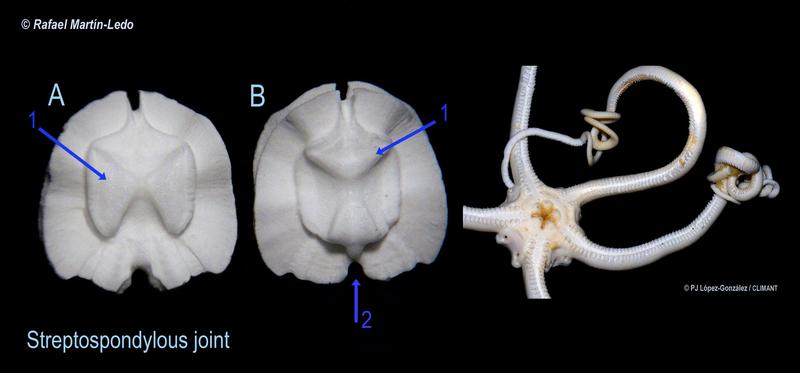In the current ophiuroids, ambulacral plates are interlocking in pairs and form the vertebrae, joint pieces of each arm segment; ambulacral furrow transformed in an internal epineural canal. This is one of the characters that distinguish the current Ophiuroidea from the Asteroidea.
There are basically two types of vertebrae that determine the kind of life of the Brittle stars. In systematic this character is of great taxonomic value.
+ Long flexible arms that can curl vertically; vertebrae with streptospondylous type joints: Order Euryalida Lamarck, 1816

Astrotoma agassizii A,distal surface; B,proximal surface 1, hour-glass projection; 2, canal for radial nerve
+ The arms with snake-like horizontal movements; vertebrae with zygospondylous type joints (except for Hemieuryalidae): Order Ophiurida Müller & Troschel, 1840

Ophionotus victoriae A,distal surface; B,proximal surface; 1,canal for radial nerve; 2,fossa for lower intervertebral muscle; 3,fossa for upper intervertebral muscles; 4, central projection; 5, central depression
References
Bernasconi, I. & D'Agostino, M.M. (1971) Ofiuroideos argentinos. Claves para los órdenes, subordenes, familias, subfamilias y generos. Physis, 30, 447–469 / Fell, H.B. (1960) Synoptic keys to the genera of Ophiuroidea. Zoology Publications from Victoria University of Wellington, 26, 1–44 / Hyman LH (1955) The Invertebrates: Echinodermata Vol 4. McGraw-Hill Press, New York / Smith, A.B., Paterson, G.L.J. & Lafay, B. (1995) Ophiuroid phylogeny and higher taxonomy: morphological, molecular and palaeontological perspectives. Zoological Journal of the Linnean Society, 114, 213–243
